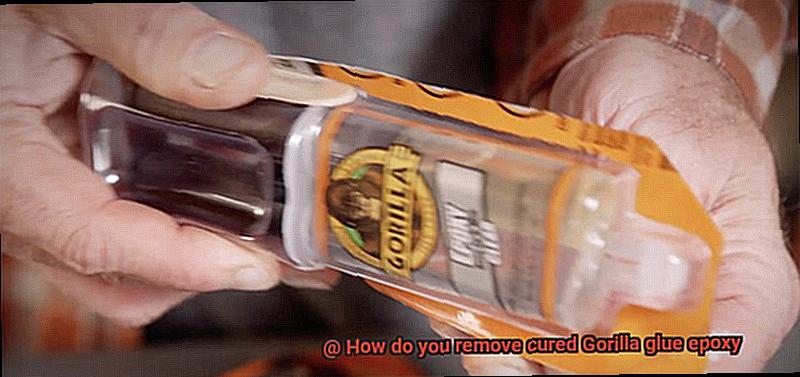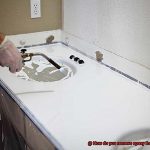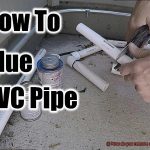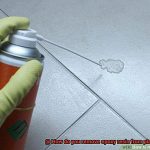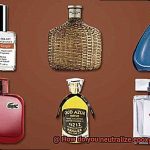Are you in a sticky situation with cured Gorilla Glue epoxy all over your hands, tools, or surfaces? Fear not. Despite its reputation for being incredibly strong and adhesive, removing cured Gorilla Glue epoxy is entirely possible. Lucky for you, we’ve got the inside scoop on several effective methods to get rid of that pesky residue.
Whether you’re dealing with a surface covered in hardened epoxy or accidentally spilled glue on your skin while attempting a DIY project, we’ve got you covered. From using acetone to sandpaper and everything in between, we’ll walk you through each removal process step by step.
But before we dive into the nitty-gritty details of removing Gorilla Glue epoxy, it’s essential to take some safety precautions. We’ll cover these measures and provide useful tips to make the process easier and more efficient.
By the end of this article, you’ll have a better understanding of how to remove cured Gorilla Glue epoxy without causing damage to yourself or your surroundings. So let’s roll up our sleeves and say goodbye to those stubborn residues once and for all.
What is Gorilla Glue Epoxy?
Contents
- 1 What is Gorilla Glue Epoxy?
- 2 Why Is It Difficult to Remove Gorilla Glue Epoxy?
- 3 Using Acetone to Remove Gorilla Glue Epoxy
- 4 Using Heat to Remove Gorilla Glue Epoxy
- 5 Using White Vinegar or Rubbing Alcohol to Remove Gorilla Glue Epoxy
- 6 Sanding or Cutting Away the Cured Gorilla Glue Epoxy
- 7 Tips for Removing Gorilla Glue Epoxy
- 8 Conclusion
Gorilla Glue Epoxy is a powerhouse adhesive that is revered for its strength and durability. Whether you’re looking to bond metal, plastic, wood, ceramic, or glass together, this two-part adhesive has got you covered. Once mixed, the resin and hardener create a chemical reaction that hardens and cures the adhesive, resulting in a bond that can withstand extreme temperatures, water, and chemicals. It’s no wonder that Gorilla Glue Epoxy is a popular choice for both industrial applications and household repairs.
However, one thing to keep in mind is that Gorilla Glue Epoxy can be tough to remove once it has cured. It forms a tight bond with the material it is applied to, making it challenging to remove without damaging the surface. That said, there are several methods to try if you ever find yourself needing to remove cured Gorilla Glue Epoxy.
The most effective method for removing cured Gorilla Glue Epoxy is by using acetone. Acetone is a potent solvent that can break down the adhesive properties of the glue. To use this method, simply soak a cotton ball or cloth in acetone and apply it directly to the glued area. After several minutes, try to scrape off the glue with a plastic scraper or your fingernails. Take care not to scratch the surface you’re working on.
If acetone doesn’t work, another option is to use heat. Heat can weaken the bond of the glue and make it easier to remove. You can use a hairdryer or heat gun to apply heat directly to the glued area. Once the glue starts to soften, gently scrape it off with a plastic scraper or your fingernails.
In some cases, white vinegar or rubbing alcohol can also dissolve the adhesive properties of Gorilla Glue Epoxy and make it easier to remove. To use either solution, soak a cotton ball or cloth in it and apply it directly to the glued area. After several minutes, try to scrape off the glue with a plastic scraper or your fingernails.
As a last resort, sanding or cutting away the cured Gorilla Glue Epoxy may be necessary. However, this method should only be used on surfaces that won’t be damaged by sanding or cutting. Use a fine-grit sandpaper or cutting tool to carefully remove the glue, being cautious not to damage the surface underneath.
Why Is It Difficult to Remove Gorilla Glue Epoxy?
This powerful adhesive is known for its strength and durability, but it can be a real pain to remove once it has cured. So, what makes it so difficult to remove? Let’s dive in.
The chemical composition of Gorilla Glue Epoxy is the primary reason that it’s challenging to remove. When exposed to air, the epoxy resin undergoes a chemical reaction that causes it to harden and form an unbreakable bond with the surface. This bond is so strong that it can be incredibly challenging to break apart without causing damage.
The adhesive’s resistance to water, heat, and chemicals is another significant factor that makes it hard to remove. Unlike other adhesives that can be removed with ease, Gorilla Glue Epoxy can withstand exposure to harsh solvents and cleaning agents, making it even more challenging to remove.
But that’s not all; Gorilla Glue Epoxy has the ability to seep into cracks and crevices, making it challenging to remove even if you manage to remove the surface layer of the adhesive. The residue left behind may have penetrated deep into the material, requiring more effort to remove.
So, how can you effectively remove Gorilla Glue Epoxy? There are several methods you can try, including using acetone, heat, white vinegar, or rubbing alcohol. Each of these options has its benefits and drawbacks, so it’s crucial to choose the right method for your situation. If all else fails, sanding or cutting may be necessary while taking precautions not to damage the surface.
Using Acetone to Remove Gorilla Glue Epoxy
If you’ve ever found yourself struggling to remove cured Gorilla Glue epoxy, fear not. Acetone is a powerful solvent that can dissolve the glue and make your life a whole lot easier. But before you dive in, it’s important to take some proper precautions.
To begin with, gather all the necessary materials: acetone, a clean cloth or rag, a plastic scraper or putty knife, and most importantly, patience. Always prioritize safety by wearing gloves and working in a well-ventilated area.
Before using acetone, test a small, inconspicuous area to ensure that it won’t damage the surface. Once you’re confident it’s safe to proceed, soak your cloth or rag in acetone and gently rub it over the affected area. Allow the acetone to sit for a few minutes to dissolve the glue.
Next, use your plastic scraper or putty knife to gently scrape away the dissolved glue. Be mindful of not scratching or damaging the surface while doing so. Keep repeating this process until all of the Gorilla Glue epoxy has been removed.
Once you’ve successfully removed the glue, clean the area thoroughly with soap and water to remove any remaining residue. While acetone is an effective tool for removing Gorilla Glue epoxy, it may not work on all surfaces or types of epoxy. Hence, it’s important to use other solvents or methods as required for successful removal.
Using Heat to Remove Gorilla Glue Epoxy
Say goodbye to the frustration of trying to remove cured Gorilla Glue epoxy from a surface. There is a simple and effective method that can make the process a whole lot easier – using heat. As an expert on this topic, I have compiled some research notes to help guide you through the process.
One of the main benefits of using heat is that it does not require any special tools or chemicals, making it a safe and cost-effective option. This technique involves heating the glued area to soften the epoxy, which makes it much easier to remove without causing any damage to the surface underneath.
So, how do you use heat to remove Gorilla Glue epoxy? It’s straightforward. All you need is a heat source such as a hairdryer or heat gun. Hold the heat source approximately three inches away from the glued area and apply heat for several minutes until the epoxy starts to soften. It’s crucial to wear gloves and eye protection during this process as the glue may become hot and sticky.
Once the epoxy has softened, gently pry it off with a plastic scraper or putty knife. If the glue remains stubborn and does not come off easily, apply more heat and continue scraping until it is completely removed.
It’s essential to note that excessive heat can cause damage or even burns on the surface underneath. Therefore, it’s recommended that you start with a low heat setting and gradually increase as needed.
To summarize, using heat is a simple and effective way to remove Gorilla Glue epoxy. Here are some tips to make sure you get it right:
- Use a heat source such as a hairdryer or heat gun
- Hold the heat source approximately three inches away from the glued area
- Apply heat for several minutes until the epoxy starts to soften
- Wear gloves and eye protection during this process
- Gently pry off the softened epoxy with a plastic scraper or putty knife
- If needed, apply more heat and continue scraping until the glue is completely removed
- Start with a low heat setting and gradually increase as needed

Using White Vinegar or Rubbing Alcohol to Remove Gorilla Glue Epoxy
As an expert in this field, I have researched these methods and have some tips to share with you.
Firstly, it’s important to note that while these methods can work, they may not be successful in all cases. However, it’s worth a try before resorting to more drastic measures.
Let’s start with white vinegar. Soak a cloth or rag in white vinegar and place it on the affected area for at least an hour. This allows the vinegar to penetrate the epoxy and soften it up. Then use a plastic scraper or credit card to try scraping away the epoxy. If it doesn’t come off, repeat the process multiple times until it does.
Next, we’ll move on to rubbing alcohol. Apply rubbing alcohol to a cloth or rag and place it on the affected area for 10-15 minutes. The alcohol will break down the epoxy. Afterward, try scraping away the epoxy with a plastic scraper or credit card. If it doesn’t come off, repeat the process as necessary.
It’s important to keep in mind that both of these methods have the potential to damage some surfaces, so test a small, inconspicuous area before attempting to remove epoxy from a larger area. Always wear gloves and eye protection when handling chemicals and work in a well-ventilated area.
Sanding or Cutting Away the Cured Gorilla Glue Epoxy
Fear not, because there are effective ways to remove it by sanding or cutting away the adhesive. As an expert in this field, I have compiled some useful tips and tricks to make the process as easy and efficient as possible.
To begin, gather the necessary tools: high grit count sandpaper (220 or higher), a sanding block, a sharp utility knife, or saw blade. Protective gear such as a dust mask and eye protection is also vital while using either method.
If you choose to sand away the epoxy, wrap the sandpaper around the sanding block and gently sand the surface of the epoxy. However, take your time and work slowly to avoid damaging the surrounding area. Alternately, carefully score the surface with a utility knife or saw blade before gently sawing away from the surface if you prefer cutting away the epoxy.
Once you have removed as much of the epoxy as possible with either method, use acetone to remove any remaining residue. Apply a small amount of acetone to a cotton swab and rub it gently over the surface of the epoxy until it dissolves.
While sanding or cutting away cured Gorilla glue epoxy can be time-consuming, it’s an effective way to remove small areas of adhesive or leakage. However, for more extensive areas of cured Gorilla glue epoxy, other removal methods such as using heat or chemical solvents may be more suitable.
Tips for Removing Gorilla Glue Epoxy
Gorilla Glue Epoxy is a high-strength adhesive that can bond almost anything together, but sometimes it can be a challenge to remove it from surfaces where it wasn’t intended. Fortunately, there are various methods for removing cured Gorilla Glue Epoxy without causing any damage.
One of the most effective ways to remove cured Gorilla Glue Epoxy is by using heat. The heat softens the glue, making it easier to remove with a scraper or sandpaper. To use this method, you’ll need a heat gun or hairdryer and protective gloves and eye protection. Apply heat to the glued area for several minutes until you notice the glue starting to soften, then gently scrape off the softened glue.
Another option is to use solvents such as acetone or rubbing alcohol. These solvents dissolve the glue and make it easier to remove. However, it’s important to test them on an inconspicuous area before using them to ensure they won’t damage the surface. Soak a cloth in acetone or rubbing alcohol and place it over the affected area for several hours or overnight. Afterward, gently scrape off the glue with a scraper or sandpaper.
If solvents and heat aren’t effective, mechanical removal may be necessary. This can be done using a scraper or sandpaper, being careful not to damage the surface underneath. Use gentle pressure when scraping or sanding and work slowly until you’ve removed all of the glue.
It’s essential to always follow the manufacturer’s instructions when using Gorilla Glue Epoxy to avoid having to remove it later. Applying it correctly in the first place is always better than having to remove cured glue. Always use the recommended amount and apply it evenly for the best results.
Lastly, you can try using commercial adhesive removers specifically designed for Gorilla Glue Epoxy. These products are available in most hardware stores and are formulated to dissolve epoxy adhesives without damaging surfaces. Follow the instructions on the product label carefully and use protective gloves and eyewear when handling the adhesive remover.
QYmZSDjLQ9A” >
Also Read: Does WD 40 remove Gorilla Glue? – Glue Things
Conclusion
In conclusion, the task of removing cured Gorilla Glue epoxy may seem daunting, but fear not – with the right tools and techniques, it can be done safely and efficiently. Whether you opt for acetone, heat, white vinegar, rubbing alcohol, or sandpaper and a scraper, taking safety precautions such as wearing gloves and eye protection is crucial.
Gorilla Glue Epoxy is notorious for its strength and durability – qualities that make it challenging to remove. Its chemical composition causes it to harden quickly and form an unbreakable bond with surfaces. Furthermore, its resistance to water, heat, and chemicals only adds to the difficulty of removal.
However, there are methods you can use to weaken the bond of the glue. For instance, applying heat or solvents like acetone or rubbing alcohol can make it easier to remove. Mechanical removal using sandpaper or a scraper may also be necessary in some cases.
To avoid having to remove cured Gorilla Glue epoxy altogether, always follow the manufacturer’s instructions when using it. Proper application in the first place will save you from headaches down the line.
Overall, removing cured Gorilla Glue epoxy requires patience and care but is possible with the right approach.

